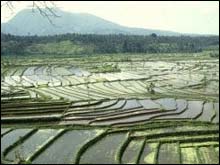Information and reporting system for water and agriculture in Asian monsoon area

Compared to other areas of the world, irrigated agriculture is most intensively practiced in the monsoon areas of Asia. Worldwide around 20% of all cultivated land is irrigated. But in the monsoon areas of South and South East Asia 38% of all agriculture is irrigated, compared to 34% in North Africa and the Near East, 13% in Latin America, 3% in Sub-Saharan Africa and 12% in industrialised countries. In these monsoon areas, the agricultural sector uses about 80% of all water that is withdrawn and 45% of all irrigated land is estimated to be cultivated with paddy rice. It is therefore recommendable to optimise the water use for paddy irrigation in order to save water for other purposes.
The "Information and reporting system for water and agriculture in Asian monsoon areas" was funded by the Japanese Government through the project GCP/INT/861/JPN: "Evaluation Study of Paddy Irrigation under Monsoon Regime" (ESPIM).
By providing a possibility to assess and monitor the irrigation and drainage sector in the Asian Monsoon region in general and the paddy production systems in particular, the ESPIM-project helped address the three main issues of major importance related to irrigated agriculture:
- the impact of irrigation and drainage in paddy production on the natural water balance;
- the role of irrigation and drainage in paddy production in global food production and food security;
- the relation between irrigated agriculture and the environment in the Asian Monsoon region.
The objectives of the ESPIM-project to address these issues were defined as:
- developing an information and reporting system for water in agriculture under monsoon regime;
- promoting and developing improved monitoring capacities regarding irrigation and drainage;
- assisting in policy-making processes for improving management of agricultural water resources.
